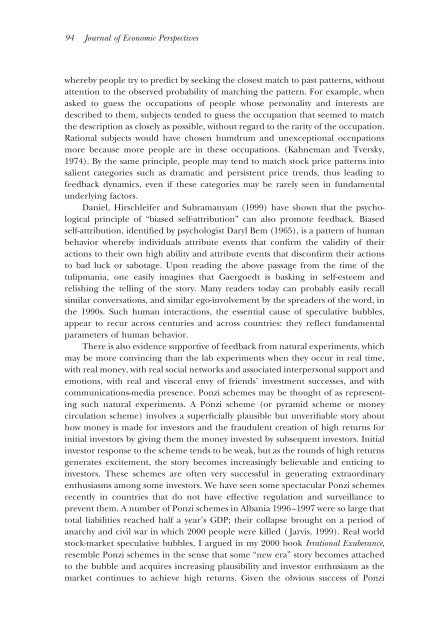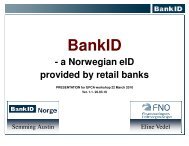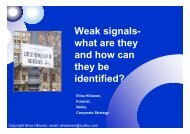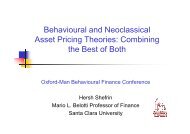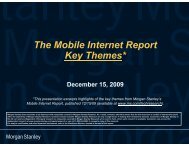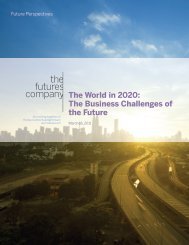From Efficient Markets Theory to Behavioral Finance
From Efficient Markets Theory to Behavioral Finance
From Efficient Markets Theory to Behavioral Finance
You also want an ePaper? Increase the reach of your titles
YUMPU automatically turns print PDFs into web optimized ePapers that Google loves.
94 Journal of Economic Perspectives<br />
whereby people try <strong>to</strong> predict by seeking the closest match <strong>to</strong> past patterns, without<br />
attention <strong>to</strong> the observed probability of matching the pattern. For example, when<br />
asked <strong>to</strong> guess the occupations of people whose personality and interests are<br />
described <strong>to</strong> them, subjects tended <strong>to</strong> guess the occupation that seemed <strong>to</strong> match<br />
the description as closely as possible, without regard <strong>to</strong> the rarity of the occupation.<br />
Rational subjects would have chosen humdrum and unexceptional occupations<br />
more because more people are in these occupations. (Kahneman and Tversky,<br />
1974). By the same principle, people may tend <strong>to</strong> match s<strong>to</strong>ck price patterns in<strong>to</strong><br />
salient categories such as dramatic and persistent price trends, thus leading <strong>to</strong><br />
feedback dynamics, even if these categories may be rarely seen in fundamental<br />
underlying fac<strong>to</strong>rs.<br />
Daniel, Hirschleifer and Subramanyam (1999) have shown that the psychological<br />
principle of “biased self-attribution” can also promote feedback. Biased<br />
self-attribution, identified by psychologist Daryl Bem (1965), is a pattern of human<br />
behavior whereby individuals attribute events that confirm the validity of their<br />
actions <strong>to</strong> their own high ability and attribute events that disconfirm their actions<br />
<strong>to</strong> bad luck or sabotage. Upon reading the above passage from the time of the<br />
tulipmania, one easily imagines that Gaergoedt is basking in self-esteem and<br />
relishing the telling of the s<strong>to</strong>ry. Many readers <strong>to</strong>day can probably easily recall<br />
similar conversations, and similar ego-involvement by the spreaders of the word, in<br />
the 1990s. Such human interactions, the essential cause of speculative bubbles,<br />
appear <strong>to</strong> recur across centuries and across countries: they reflect fundamental<br />
parameters of human behavior.<br />
There is also evidence supportive of feedback from natural experiments, which<br />
may be more convincing than the lab experiments when they occur in real time,<br />
with real money, with real social networks and associated interpersonal support and<br />
emotions, with real and visceral envy of friends’ investment successes, and with<br />
communications-media presence. Ponzi schemes may be thought of as representing<br />
such natural experiments. A Ponzi scheme (or pyramid scheme or money<br />
circulation scheme) involves a superficially plausible but unverifiable s<strong>to</strong>ry about<br />
how money is made for inves<strong>to</strong>rs and the fraudulent creation of high returns for<br />
initial inves<strong>to</strong>rs by giving them the money invested by subsequent inves<strong>to</strong>rs. Initial<br />
inves<strong>to</strong>r response <strong>to</strong> the scheme tends <strong>to</strong> be weak, but as the rounds of high returns<br />
generates excitement, the s<strong>to</strong>ry becomes increasingly believable and enticing <strong>to</strong><br />
inves<strong>to</strong>rs. These schemes are often very successful in generating extraordinary<br />
enthusiasms among some inves<strong>to</strong>rs. We have seen some spectacular Ponzi schemes<br />
recently in countries that do not have effective regulation and surveillance <strong>to</strong><br />
prevent them. A number of Ponzi schemes in Albania 1996–1997 were so large that<br />
<strong>to</strong>tal liabilities reached half a year’s GDP; their collapse brought on a period of<br />
anarchy and civil war in which 2000 people were killed ( Jarvis, 1999). Real world<br />
s<strong>to</strong>ck-market speculative bubbles, I argued in my 2000 book Irrational Exuberance,<br />
resemble Ponzi schemes in the sense that some “new era” s<strong>to</strong>ry becomes attached<br />
<strong>to</strong> the bubble and acquires increasing plausibility and inves<strong>to</strong>r enthusiasm as the<br />
market continues <strong>to</strong> achieve high returns. Given the obvious success of Ponzi


